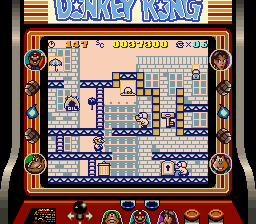Donkey Kong (1994 video game) facts for kids
Quick facts for kids Donkey Kong |
|
|---|---|

North American box art
|
|
| Developer(s) | Nintendo EAD Pax Softnica |
| Publisher(s) | Nintendo |
| Director(s) |
|
| Producer(s) | Shigeru Miyamoto |
| Designer(s) | Hideo Kon Kenta Usui Takaya Imamura |
| Programmer(s) |
|
| Artist(s) | Yoichi Kotabe |
| Composer(s) | Taisuke Araki |
| Series | Donkey Kong |
| Platform(s) | Game Boy |
| Release date(s) |
|
| Genre(s) | Platform, puzzle |
| Mode(s) | Single-player |
Donkey Kong (sometimes called Donkey Kong '94) is a fun platform and puzzle game made for the Game Boy. It came out in 1994. Nintendo and Pax Softnica created it. Nintendo also published it.
This game is based on the original Donkey Kong arcade game from 1981. It also takes ideas from Donkey Kong Jr.. In the game, you play as Mario. Your goal is to rescue Pauline from Donkey Kong. Both Mario and Donkey Kong have updated looks in this game. Sometimes, Donkey Kong Jr. even shows up to help his dad stop Mario.
Donkey Kong was the first Game Boy game to have special features. These features worked when you played it on the Super Game Boy. It mixes gameplay ideas from Donkey Kong, Donkey Kong Jr., and Super Mario Bros. 2.
How to Play the Game
The game starts with four levels that are just like the original arcade game. In these levels, Mario needs to reach the top to save Pauline. After you finish these four levels, the game seems to end. But then, Donkey Kong wakes up, grabs Pauline again, and runs off! Mario has to chase him.
Then, you get to play 97 more levels across nine different worlds. This means there are 101 levels in total. The very last level is a big fight against a giant, changed Donkey Kong.
The levels after the first four are different. Mario must find a key in each level. He then needs to carry this key to a locked door somewhere else in the stage. Every fourth level is a "battle level." Here, you either try to reach Pauline or defeat Donkey Kong. You can defeat him by using his own barrels against him.
After every fourth level, a short video plays. This video shows you new moves Mario can do. It also shows new traps you might see in the next levels. At this point, you can save your game progress. You can also see how fast you finished each level. You can earn extra lives by playing mini-games. You unlock these mini-games by collecting three special items in each level. You can also get extra lives based on how much time you have left at the end of a set of levels.
Mario has many new moves in this game. He can fall from certain heights without losing a life. But if he falls too far, he will lose a life. If Mario touches an enemy or obstacle, he usually loses a life. However, sometimes he can take a hit, like when he is carrying an item. Like in Super Mario Bros. 2, Mario can pick up and throw items or certain enemies. He needs to do this to carry the key to the door. If you leave the key alone for too long, it will go back to where it started.
Mario can also flip onto his hands. This lets him catch falling barrels. He can also jump higher by timing his jumps from flipping. Or he can jump higher by changing direction while jumping. The classic hammer item can now be thrown upwards. If Mario catches it, he can use it again. This lets him bring the hammer to different parts of the level. There are also special blocks that let you add bridges, ladders, and springs anywhere on the screen for a short time. Mario can also swim, climb ropes like in Donkey Kong Jr., and spin on wires to reach new places.
What Came After
When Donkey Kong for Game Boy came out, a company called Nelsonic made a special LCD game watch. It was based on one of the early levels from the original game.
Ten years later, Nintendo planned to make an improved version of the Game Boy game for the Game Boy Advance. It was going to be called Donkey Kong Plus. This new version would have better graphics and backgrounds. It was also going to let players create their own levels using the GameCube. This game eventually became Mario vs. Donkey Kong. This was a completely new game but with similar gameplay. It later got a sequel called Mario vs. Donkey Kong 2: March of the Minis, which also let players design levels.
The original Game Boy Donkey Kong game was re-released. You could download it for the Nintendo 3DS Virtual Console service in June 2011.
See also
 In Spanish: Donkey Kong (Game Boy) para niños
In Spanish: Donkey Kong (Game Boy) para niños


